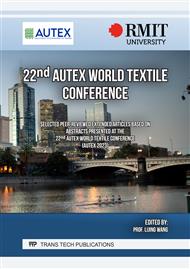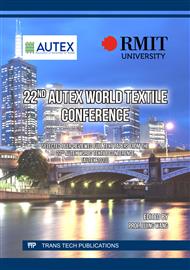[1]
L. Jajpura, A. Rangi, and A. Khandual, Natural finishes, technologies and recent developments. In: Nayak, R. (Ed). Sustainable Technologies for Fashion and Textiles. Woodhead Publishing, 2020.
DOI: 10.1016/b978-0-08-102867-4.00010-4
Google Scholar
[2]
N. Rani, Jajpura, L. and B.S. Butola, Extract Optimisation for Natural Herb Kalanchoe-Pinnata, J. Basic Appl. Eng. Res., Vol. 4, (no.1), (2017), pp.44-48.
Google Scholar
[3]
N. Abdel-Zaher, A. El-Ebissy and E. Al-Amoudy, Application of Novel Eco-friendly Natural Dye Extracted from Leaves of Neem on Silk Fabric, Asian J. Phys. Chem. Sci., Vol. 5, (no.4), (2018), pp.1-16.
DOI: 10.9734/ajopacs/2018/40614
Google Scholar
[4]
M.Yusuf, F. Mohammad, M.Shabbir and M.A. Khan, Eco-dyeing of wool with Rubia cordifolia root extract: Assessment of the effect of Acacia catechu as biomordant on color and fastness properties, Text. Cloth. Sustain., Vol. 2, (no.10), (2017).
DOI: 10.1186/s40689-016-0021-6
Google Scholar
[5]
M. Yusuf, S.A. Khan, M. Shabbir and F. Mohammad, Developing a Shade Range on Wool by Madder (Rubia cordifolia) Root Extract with Gallnut (Quercus infectoria) as Biomordant, J. Nat. Fibers, Vol. 14, (no.4), (2017), pp.597-607.
DOI: 10.1080/15440478.2016.1240641
Google Scholar
[6]
A.M. Ribeiro, B.N. Estevinho and F. Rocha, The progress and application of vitamin E encapsulation-A review, Food Hydrocoll., Vol. 121, (2021), 106998.
DOI: 10.1016/j.foodhyd.2021.106998
Google Scholar
[7]
A. Önal, Ş. Oruç, Kuşburnu (Rosa canina) meyvelerinden elde edilen ekstrakt ile pamuklu ve yünlü kumaşların boyanma özelliklerinin incelenmesi, Gaziosmanpaşa Bilim. Araştırma Derg., Vol. 1, (2012), pp.21-26.
Google Scholar
[8]
R. Tozzi, N. Mulinacci, K. Storlikken, I. Pasquali, F.F. Vincieri and R. Bettini, Supercritical extraction of carotenoids from Rosa canina L. Hips and their formulation with β-Cyclodextrin, AAPS PharmSciTech, Vol. 9, (no.2), (2008), pp.693-700.
DOI: 10.1208/s12249-008-9100-6
Google Scholar
[9]
S. Nojavan, F. Khalilian, F. M. Kiaie, A. Rahimi, A. Arabanian and S. Chalavi, Extraction and quantitative determination of ascorbic acid during different maturity stages of Rosa canina L. fruit, J. Food Compos. Anal., vol. 21, no. 4, (2008), pp.300-305.
DOI: 10.1016/j.jfca.2007.11.007
Google Scholar
[10]
Z. Ilbay, S. Şahin, and Ş.I. Kirbaşlar, Optimisation of ultrasound-assisted extraction of rosehip (Rosa canina L.) with response surface methodology, J. Sci. Food Agric., Vol. 93, (no.11), (2013), pp.2804-2809.
DOI: 10.1002/jsfa.6104
Google Scholar
[11]
Stănilă A.,et al., Extraction and characterization of phenolic compounds from rose hip (Rosa canina L.) using liquid chromatography coupled with electrospray ionization - mass spectrometry, Not. Bot. Horti Agrobot. Cluj-Napoca, Vol. 43, (no.2), (2015), pp.349-354.
DOI: 10.15835/nbha.43.2.10028
Google Scholar
[12]
D. Ozyurt, B. Demirata, R. Apak, J.F. Hamilton, A.C. Lewis and M.Z. Ozel, GC×GC-TOF/MS chromatographic analysis, antioxidant capacity and phenolic content of Rosa Canina L. at different maturities, Rec. Nat. Prod., vol. 10, (no.4), (2016), pp.407-425.
Google Scholar
[13]
A. Tahirović, N. Bašić, Determination of Phenolic Content and Antioxidant Activity of Rosa Canina L. Fruits in Different Extraction Systems, Work. Fac. For. Univ. Sarajev., (no.1), (2017), pp.47-59.
DOI: 10.54652/rsf.2017.v47.i1.66
Google Scholar
[14]
D. Paunović, et al., Assessment of chemical and antioxidant properties of fresh and dried rosehip (Rosa canina L.), Not. Bot. Horti Agrobot. Cluj-Napoca, Vol. 47, (no.1), (2019), pp.108-113.
DOI: 10.15835/nbha47111221
Google Scholar
[15]
Z. Sanaei, M. Ramezanzadeh, G. Bahlakeh and B. Ramezanzadeh, Use of Rosa canina fruit extract as a green corrosion inhibitor for mild steel in 1 M HCl solution: A complementary experimental, molecular dynamics and quantum mechanics investigation, Journal of Industrial and Eng. Chem., Vol. 69, (2019), pp.18-31.
DOI: 10.1016/j.jiec.2018.09.013
Google Scholar
[16]
R. Atakan, J. Gisbert-Payá, P. Díaz-García, M. Bonet-Aracil, Obtención de fitocomponentes de Rosa Cania a partir de la extracción con ultrasonidos, in IX. Congreso I+D+i Campus de Alcoi. Creando Sinergias, (2022), pp.161-164.
Google Scholar
[17]
M. Bonet-Aracil, P. Díaz-García, E. Bou-Belda, N. Sebastiá, A. Montoro and R. Rodrigo, UV protection from cotton fabrics dyed with different tea extracts, Dye. Pigment., Vol. 134, (2016), pp.448-452.
DOI: 10.1016/j.dyepig.2016.07.045
Google Scholar
[18]
M.F. Queiroz, K.R. Teodosio Melo, D. A. Sabry, G. L. Sassaki and H.A. Oliveira Rocha, Does the use of chitosan contribute to oxalate kidney stone formation?, Mar. Drugs, Vol. 13, (no.1), (2015), pp.141-158.
DOI: 10.3390/md13010141
Google Scholar
[19]
S. Kumari and R. Kishor, Chitin and chitosan: origin, properties, and applications. In: S. Gopi, S. Thomas and A. Pius (Ed.). Handbook of Chitin and Chitosan, Elsevier, 2020, pp.1-33.
DOI: 10.1016/b978-0-12-817970-3.00001-8
Google Scholar
[20]
T. Toprak-Cavdur, S. Uysal and J. Gisbert-Paya, Dyeing Recycled Cotton Fibers Using Curcuma Longa and Pterocarpus Santalinus Natural Dyes and Bio-mordant Chitosan, J. Nat. Fibers, Vol. 19, (no.16), (2022), pp.13736-13752.
DOI: 10.1080/15440478.2022.2105469
Google Scholar
[21]
A.B. Vino, P. Ramasamy, V. Shanmugam and A. Shanmugam, Extraction, characterization and in vitro antioxidative potential of chitosan and sulfated chitosan from Cuttlebone of Sepia aculeata Orbigny, 1848, Asian Pac. J. Trop. Biomed., Vol. 2, (no.1), (2012), pp.334-341.
DOI: 10.1016/s2221-1691(12)60184-1
Google Scholar
[22]
C. Song, H. Yu, M. Zhang, Y. Yang and G. Zhang, Physicochemical properties and antioxidant activity of chitosan from the blowfly Chrysomya megacephala larvae, Int. J. Biol. Macromol., Vol. 60, (2013), pp.347-354.
DOI: 10.1016/j.ijbiomac.2013.05.039
Google Scholar
[23]
S. Kim, Dyeing characteristics and UV protection property of green tea dyed cotton fabrics, Vol. 7, (no.3), (2006), pp.255-261.
DOI: 10.1007/bf02875682
Google Scholar
[24]
M. Verma, N. Gahlot, S.S. Jeet Singh and N.M. Rose, UV protection and antibacterial treatment of cellulosic fibre (cotton) using chitosan and onion skin dye, Carbohydrate Polymers, Vol. 257, (2021), 117612.
DOI: 10.1016/j.carbpol.2020.117612
Google Scholar



